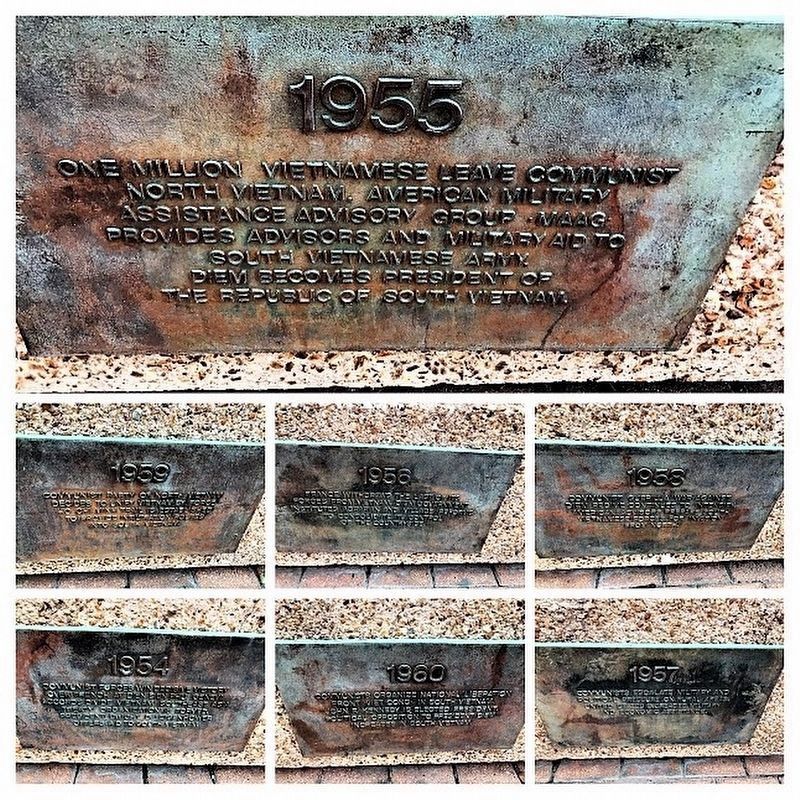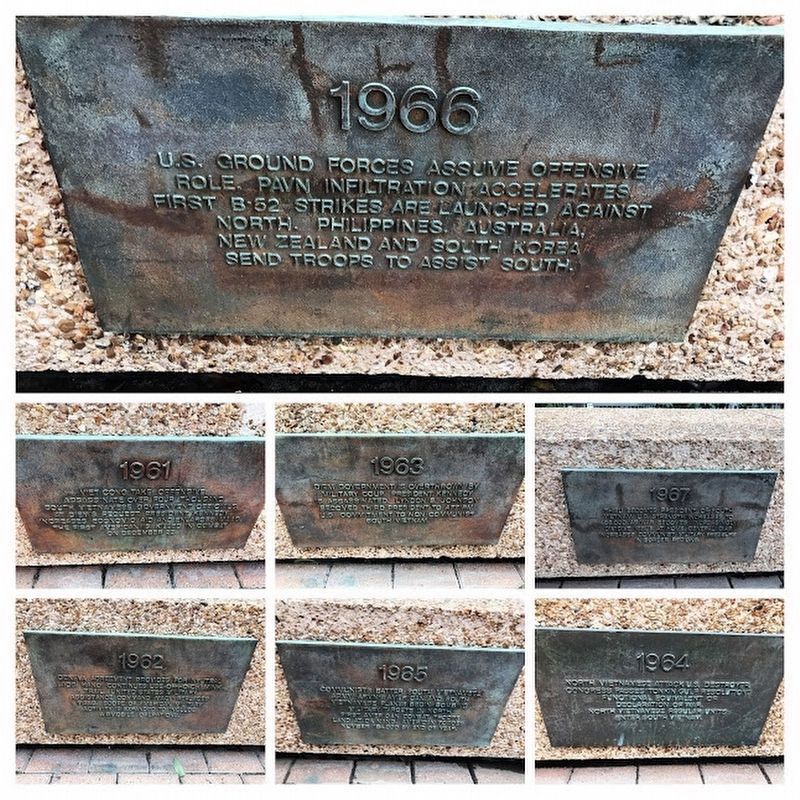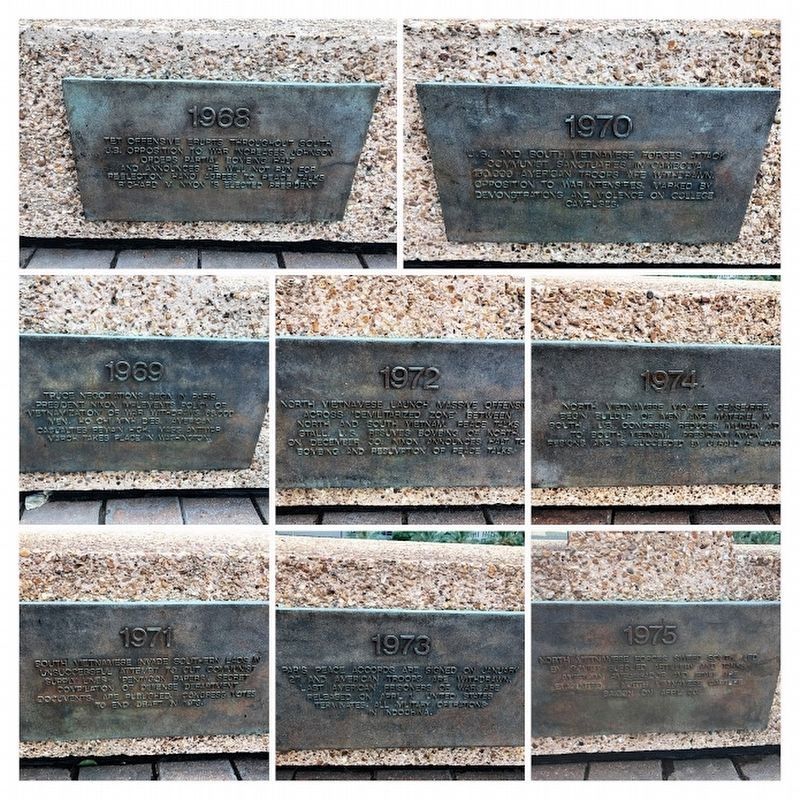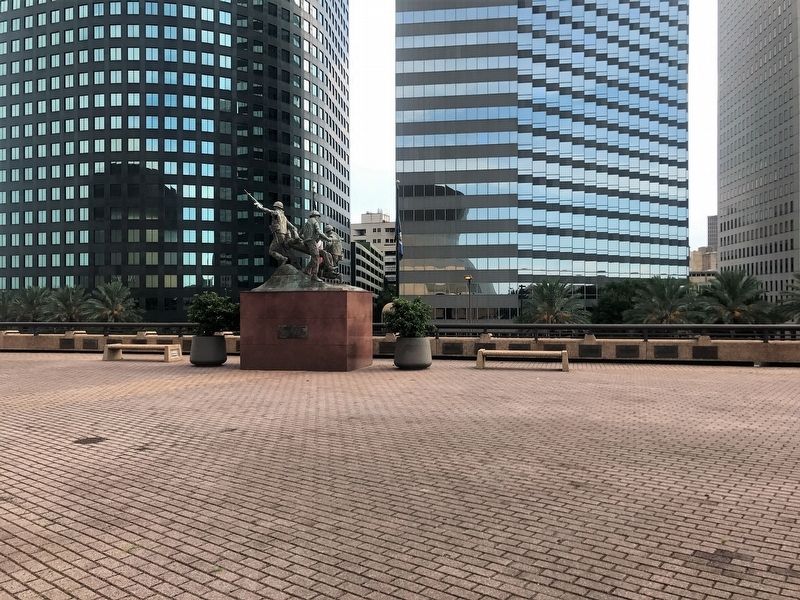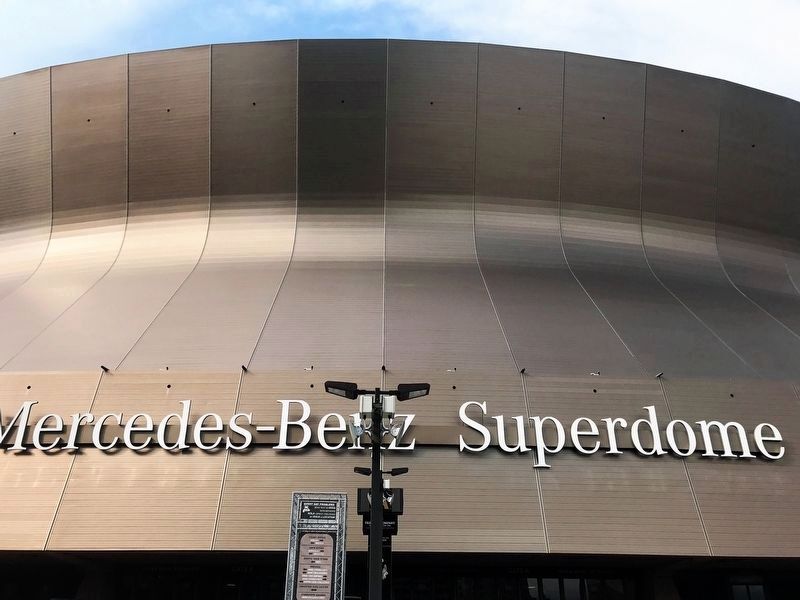Central Business District in New Orleans in Orleans Parish, Louisiana — The American South (West South Central)
Superdome Vietnam Wall
1954 Communist forces win decisive victory over French at Dien Bien Phu. Geneva Accords divide Vietnam. Southeast Asia Treaty Organization is formed. President Dwight D. Eisenhower offers aid to South Vietnam.
1955 One Million Vietnamese leave communist North Vietnam. American Military Assistance Advisory Group - MAAG - provides advisors and military aid to South Vietnamese Army. Diem becomes President of The Republic of South Vietnam.
1956 France withdraws the last of its forces from Vietnam. Diem government institutes agrarian and village reforms to consolidate its control of the countryside.
1957 Communists escalate military and political pressure on rural areas. United States increases military and economic assistance.
1958 Communist guerilla war against Diem regime continues to intensify. American advisors prepare south Vietnamese forces for invasion from north.
1959 Communist party of North Vietnam decides to unify Vietnam by force. Ho Chi Minh Trail is established to provide infiltration routes into South Vietnam
1960 Communist organize National Liberation Front -Viet Cong- in South Vietnam. John F. Kennedy elected president. Political opposition to President Diem increases in South Vietnam.
1961 Viet Cong take offensive. Assassinate over four thousand South Vietnamese government officials. At Diem's request, President Kennedy increases economic aid and enlarges MAAG. The first American is killed in combat on December 22.
1962 Geneva Agreement provides for neutral Laos. Hanoi continues use of Ho Chi Minh Trail. United States Military Assistance Command - MACV - replaces MAAG. Scope of American military activity is expanded to include airmobile operations.
1963 Diem government is overthrown by military coup. President Kennedy is assassinated. Lyndon B. Johnson becomes third president to affirm U.S. commitment to non-communist South Vietnam.
1964 North Vietnamese attack U.S.destroyer. Congress passes "Tonkin Gulf Resolution." Functional equivalent of Declaration of War. North Vietnamese regular units enter South Vietnam.
1965 Communist batter South Vietnamese army - ARVN-. American and South Vietnamese planes begin bombing military targets in north. First American combat troops land at Da Nang. American forces number 184,000 by end of year.
1966 U.S. ground troops assume offensive role. PAVN infiltration accelerates. First B-52 strikes are launched against north. Philippines, Australia, New Zealand and South Korea send troops to assist south.
1967 Thieu becomes president of South Vietnam. U.S. strength increases to 486,000 as war becomes increasingly divisive issue at home. General Giap increases Communist military pressure in border regions.
1968 Tet offensive erupts throughout the south. U.S. opposition to war increases, Johnson orders partial bombing halt and announces he will not run for re-election. Hanoi agrees to peace talks. Richard M. Nixon is elected president.
1969 Truce negotiations begin in Paris. President Nixon implements Policy of Vietnamization of War withdraws 68,000 men. Ho Chi Minh dies. American casualties remain high. Mass antiwar march takes place in Washington.
1970 U.S. and South Vietnamese forces attack communist sanctuaries in Cambodia. 150,000 American troops are withdrawn. Opposition to war intensifies, marked by demonstrations and violence on college campuses.
1971 South Vietnamese invade southern Laos in unsuccessful attempt to cut communist supply lines. 'Pentagon Papers', secret compilation of Defense Department documents, are published. Congress votes to end draft in 1973,
1972 North Vietnamese launch massive offensive across 'Demilitarized Zone' between North and South Vietnam. Peace talks stall. U.S. resumes bombing of North on December 30. Nixon announces halt to bombing and resumption of peace talks.
1973 Paris Peace Accords are signed on January 27 and American troops are withdrawn. LAst American Prisoners of War are released on April 1. United States terminates all military operations in Indochina.
1974 North Vietnamese violate cease-fire, begin buildup of men and materiel in South. U.S. Congress reduces military aid to South Vietnam. President Nixon resigns and is succeeded by Gerald R. Ford.
1975 North Vietnamese forces sweep south, led by Soviet-supplied artillery and tanks. American Ambassador and staff are evacuated. North Vietnamese capture Saigon on April 30.
Topics and series. This memorial is listed in this topic list: War, Vietnam. In addition, it is included in the Former U.S. Presidents: #34 Dwight D. Eisenhower, the Former U.S. Presidents: #35 John F. Kennedy, the Former U.S. Presidents: #36 Lyndon B. Johnson, and the Former U.S. Presidents: #37 Richard M. Nixon series lists.
Location. 29° 57.107′ N, 90° 4.779′ W. Marker is in New Orleans, Louisiana, in Orleans Parish. It is in the Central Business District. Memorial can be reached from Sugar Bowl Drive near Poydras Street. Touch for map. Marker is at or near this postal address: 1500 Sugar Bowl Drive, New Orleans LA 70112, United States of America. Touch for directions.
Other nearby markers. At least 8 other markers are within walking distance of this marker. Superdome Vietnam Memorial (here, next to this marker); John Julian McKeithen (about 600 feet away, measured in a direct line); Rebirth (about 800 feet away); Louisiana Spanish-American War Monument
(approx. ¼ mile away); The Pythian Temple (approx. ¼ mile away); The Clarinet (approx. ¼ mile away); Jazz (approx. ¼ mile away); Birdsall Building (approx. 0.4 miles away). Touch for a list and map of all markers in New Orleans.
More about this marker. Located on the second level of Superdome grounds, Poydras Street entrance, left side on short wall below Vietnam Memorial.
Credits. This page was last revised on February 12, 2023. It was originally submitted on July 24, 2017, by Cajun Scrambler of Assumption, Louisiana. This page has been viewed 287 times since then and 11 times this year. Photos: 1, 2, 3, 4, 5. submitted on July 24, 2017.
